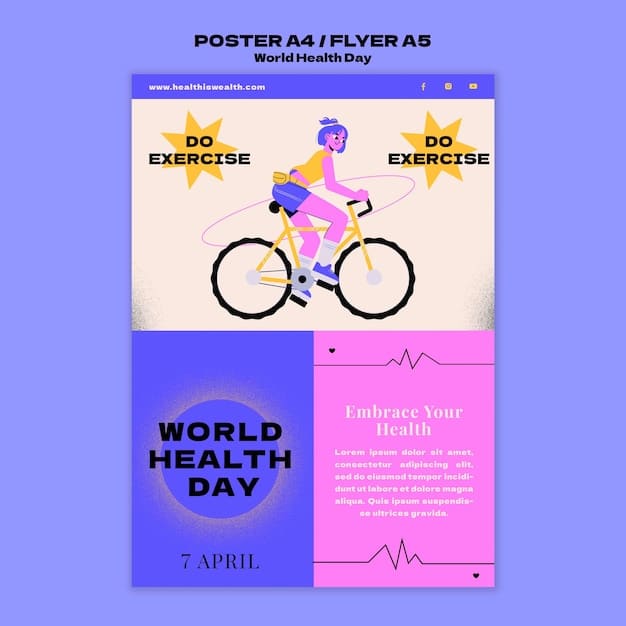How Public Health Campaigns are Transforming Health in the US

Public health campaigns in the US strategically employ education, policy changes, and community engagement to promote healthier behaviors, address disparities, and improve overall population health outcomes.
How Public Health Campaigns Are Shaping Health Behaviors in the US is a topic of increasing importance as we seek to improve the well-being of the population. Public health initiatives play a vital role in promoting healthier lifestyles and preventing diseases.
Understanding the Role of Public Health Campaigns
Public health campaigns are organized efforts to promote specific health behaviors and improve the overall health of a community or population. These campaigns often use a variety of strategies, including communication, education, and policy changes, to achieve their goals.
The primary goal of public health campaigns is to prevent disease, promote health, and reduce health disparities across different groups. By providing information, resources, and support, these campaigns empower individuals to make informed decisions about their health.
Key Components of Effective Campaigns
Several key components contribute to the effectiveness of public health campaigns. These include:
- Research and Planning: Campaigns should be based on sound research and a thorough understanding of the target audience.
- Clear Messaging: The message should be clear, concise, and easy to understand.
- Targeted Outreach: Campaigns should be tailored to the specific needs and characteristics of the target audience.
- Collaboration: Effective campaigns often involve partnerships between government agencies, healthcare providers, community organizations, and the media.
Public health campaigns are essential for addressing a wide range of health issues and promoting healthier behaviors among the population. By understanding the key components of these campaigns, we can work to improve the health of our communities.

The Impact of Anti-Smoking Campaigns
One of the most successful examples of public health campaigns in the US is the anti-smoking campaign. These campaigns have been instrumental in reducing smoking rates and raising awareness about the health risks associated with tobacco use.
Through a combination of education, policy changes, and media campaigns, anti-smoking initiatives have helped to change social norms and reduce the appeal of smoking, leading to significant public health benefits.
Strategies Used in Anti-Smoking Campaigns
Several strategies have been used in anti-smoking campaigns in the US. These include:
- Public Service Announcements: These ads often feature graphic images and personal stories to highlight the dangers of smoking.
- Smoke-Free Policies: Implementing smoke-free policies in public places and workplaces has helped to reduce exposure to secondhand smoke and discourage smoking.
- Taxation: Increasing taxes on tobacco products has been shown to reduce smoking rates, particularly among young people and low-income individuals.
- Counter-Advertising: These campaigns aim to counteract the marketing efforts of the tobacco industry by providing accurate information about the health risks of smoking.
Anti-smoking campaigns have had a significant impact on public health in the US. By reducing smoking rates, these initiatives have helped to prevent a wide range of diseases, including lung cancer, heart disease, and stroke. Continued efforts are needed to further reduce smoking rates and protect the health of all Americans.
Promoting Vaccination Through Public Health Initiatives
Vaccination is one of the most effective ways to prevent infectious diseases and protect public health. Public health campaigns play a crucial role in promoting vaccination and addressing concerns about vaccine safety and efficacy.
By providing accurate information and addressing misconceptions, these campaigns help to increase vaccination rates and reduce the spread of vaccine-preventable diseases.
Addressing Vaccine Hesitancy
Vaccine hesitancy is a significant challenge in public health. It refers to the delay in acceptance or refusal of vaccines despite their availability. Public health campaigns address vaccine hesitancy by:
- Building Trust: Establishing trust between healthcare providers and the public is essential for promoting vaccination.
- Providing Information: Accurate and accessible information about vaccine safety and efficacy is crucial for addressing concerns and misconceptions.
- Engaging Communities: Working with community leaders and trusted messengers can help to reach individuals who may be hesitant to get vaccinated.
- Addressing Misinformation: Countering misinformation about vaccines is essential for preventing the spread of false information and promoting informed decision-making.
Promoting vaccination through public health initiatives is essential for protecting individuals and communities from vaccine-preventable diseases. By addressing vaccine hesitancy and providing accurate information, we can increase vaccination rates and improve public health outcomes.
Combating Obesity Through Public Awareness Campaigns
Obesity is a major public health problem in the US, contributing to a wide range of chronic diseases, including diabetes, heart disease, and cancer. Public awareness campaigns aim to combat obesity by promoting healthy eating habits and physical activity.
These campaigns often use a variety of strategies, including education, community-based programs, and policy changes, to encourage individuals to make healthier choices.
Strategies to Promote Healthy Eating
Several strategies are used in public awareness campaigns to promote healthy eating. These include:
- Nutrition Education: Providing information about healthy foods and portion sizes can help individuals make informed choices about their diet.
- Labeling Initiatives: Clear and easy-to-understand food labels can help consumers identify healthier options.
- Community Programs: Community-based programs, such as cooking classes and farmers’ markets, can make healthy foods more accessible and affordable.
- Policy Changes: Policies such as taxes on sugary drinks and subsidies for healthy foods can help to create a healthier food environment.
Combating obesity through public awareness campaigns is essential for improving the health of the population and reducing the burden of chronic diseases. By promoting healthy eating habits and physical activity, these initiatives can help individuals achieve and maintain a healthy weight.

Mental Health Awareness Campaigns in the US
Mental health is an integral part of overall health and well-being. Mental health awareness campaigns play a crucial role in reducing stigma, promoting early intervention, and improving access to mental health services.
These campaigns often use a variety of strategies, including education, media outreach, and community events, to raise awareness and encourage individuals to seek help when they need it.
Reducing Stigma Around Mental Health
Stigma is a major barrier to seeking mental health care. Mental health awareness campaigns aim to reduce stigma by:
- Sharing Personal Stories: Sharing personal stories about mental health experiences can help to normalize mental illness and reduce feelings of shame and isolation.
- Providing Education: Educating the public about mental health conditions can help to dispel myths and misconceptions.
- Promoting Empathy: Encouraging empathy and understanding towards individuals with mental illness can help to create a more supportive and inclusive society.
- Challenging Stereotypes: Media campaigns can challenge negative stereotypes about mental illness and promote positive portrayals of individuals with mental health conditions.
Mental health awareness campaigns are essential for improving the lives of individuals with mental illness and promoting mental well-being for all. By reducing stigma and improving access to care, these initiatives can help to create a more supportive and inclusive society.
Public Health Campaigns Addressing Substance Abuse
Substance abuse is a significant public health problem in the US, contributing to a wide range of health and social problems. Public health campaigns aim to address substance abuse by preventing initiation, promoting early intervention, and supporting recovery.
This involves coordinated efforts in schools, communities, and healthcare settings to educate people about the risks associated with drug and alcohol use.
Prevention Strategies in Schools
The role of schools in mitigating substance abuse through health campaigns:
- Educational Workshops: Implementing comprehensive education workshops that teach students about the dangers of drugs and alcohol.
- Peer Support Programs: Developing peer support programs where students can share experiences and encourage positive life choices.
- Early Intervention: Identifying and intervening early with youth who may be at risk for substance abuse.
- Parental Involvement: Engaging parents in informative sessions to increase their awareness and strategies for prevention.
Campaigns addressing substance abuse should incorporate early intervention, educational programs, and community collaboration to create supportive environments that discourage drug use and promote healthier lifestyles. This comprehensive approach can lead to significant reductions in substance abuse rates.
Future Trends in Public Health Campaign Design and Implementation
The field of public health is constantly evolving, and future campaigns will need to adapt to changing demographics, technologies, and health challenges. Emerging trends are likely to shape the design and effectiveness of such campaigns.
Innovative strategies and technologies will likely play a key role in public health campaigns and improve interventions and enhance community well-being.
Leveraging Technology in Public Health Campaigns
How tech will impact these campaigns:
- Use of Mobile Technology: Utilizing mobile apps to deliver personalized health messages and track health behaviors.
- Social Media Engagement: Increasing use of social media to disseminate information, engage communities, and counter misinformation.
- Data-Driven Strategies: Using data analytics to identify high-risk groups and tailor interventions accordingly.
- Telehealth Integration: Incorporating telehealth services to provide remote counseling and support for individuals with health needs.
The future of public health campaigns will likely involve increased use of technology, personalized interventions, and collaborative partnerships to address the complex and evolving health challenges facing communities across the US.
| Key Element | Brief Description |
|---|---|
| 🎯 Campaign Goals | Objectives include disease prevention & health promotion. |
| 📢 Key Strategies | Education initiatives, policy changes, media campaigns. |
| 🛡️ Vaccination | Increase vaccination rates to combat infectious diseases. |
| 🧠 Mental Health | Reduce stigma, improve access to mental health services. |
What are the key components of a successful public health campaign?
Effective campaigns include research, clear messaging, targeted outreach, and collaboration.
What role do anti-smoking campaigns play in public health?
They reduce smoking rates through education, policy changes, and media campaigns.
How do public health initiatives promote vaccination?
By providing accurate information and addressing concerns about vaccine safety.
What strategies combat obesity through public awareness campaigns?
Nutrition education, food labeling, community programs, and policy changes.
How do mental health awareness campaigns reduce stigma?
By sharing personal stories, providing education, and challenging stereotypes.
Public health initiatives have significantly reshaped health behaviors in the US, achieving major improvements in health. From curbing smoking rates to increasing vaccination and mental health awareness, these initiatives showcase the impact of targeted interventions. Future campaigns utilizing technology and data-driven strategies can address evolving issues across US communities.





